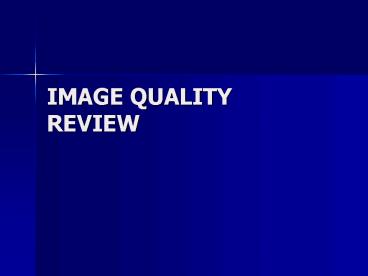IMAGE QUALITY REVIEW PowerPoint PPT Presentation
1 / 38
Title: IMAGE QUALITY REVIEW
1
IMAGE QUALITY REVIEW
2
Intended learning outcome
- The student should learn at the end of this
lecture how to produce an optimal radiological
image for diagnosis.
3
What affects DENSITYon the radiographic image?
4
Factors Affecting mAs Density
- Patient factors
- size of pt., density / pathology of tissue
- kVp
- Collimation
- Distance
- Grids
- Film/Screen Combinations
- Processing
5
Influences technique density on image
Patients Body Habitus (size)
6
Creating the Image
- Scatter
- Creates fog
- Lowers contrast (more grays)
- Increases as
- kV increases
- Field size increases
- Thickness of part increases
7
Effects of collimation on scatter
8
- Collimate to area of interest -reduces scatter
and radiation dose to the patient
9
Grids
- A device with lead strips that is placed between
the patient and the cassette - Used on larger body parts to reduce the number of
scattering photons from reaching the image
10
Grid is placedbetween patient (behind table or
upright bucky) cassetteIf placed BACWARDS CAN
CAUSE GRID ERRORS
11
GRIDS CAN LEAVE LINES ON THE IMAGE
12
Recorded Detail
- The degree of sharpness in an objects borders
and structural details. - Other names
- -sharpness of detail
- -definition
- -resolution
- -degree of noise
13
2 principal characteristics of any image are
Spatial Contrast Resolution
- Spatial resolution
- Resolution is the ability to image two separate
objects and visually distinguish one from the
other - Spatial resolution is the ability to image small
objects that have high subject contrast (eg.
bone-soft tissue interface, calcified lung
nodules)
14
2 principal characteristics of any image are
Spatial Contrast Resolution
- Spatial resolution
- Determined by focal-spot size and other factors
that contribute to blur - Diagnostic x-ray has excellent spatial
resolution. It is measured in line pairs per mm.
(CT measured in cm)
15
Factors that affect the detail of an image
16
Main Factors Affecting Recorded Detail
- kVp mAs
- Motion
- Object Unsharpness
- Focal Spot Size
- SID (Source to Image Distance)
- OID (Object to Image Distance)
- Material Unsharpness
17
GEOMETRIC QUALITIES
- DETAIL
- DISTORTION
- MAGNIFICATION
18
(No Transcript)
19
- POOR
- DETAIL
- GOOD DETAIL
20
Motion
- Can be voluntary or involuntary
- Best controlled by short exposure times
- Use of careful instructions to the pt.
- Suspension of pt. respiration
- Immobilization devices
21
Decrease Motion Unsharpness
- Instruct patient not to move or breath
- Use Immobilization devices
- Use Short exposure times
- Lock equipment in place
22
Blurring of image due to patient movement during
exposure.
23
SID Source to Image Distance
- The greater the distance between the source of
the x-ray (tube) and the image receptor
(cassette), the greater the image sharpness. - Standard distance 40 in. most exams
- Exception Chest radiography 72 in.
24
(No Transcript)
25
OIDObject to Image Distance
- The closer the object to the film, the sharper
the detail. - OID ?, penumbra ?, sharpness ?
- OID ?, penumbra ?, sharpness ?
- Structures located deep in the body, radiographer
must know how to position to get the object
closest to the film.
26
Focal spot size determined by filament in
cathode surface area used at anode
27
(No Transcript)
28
Distortion
- Misrepresentation of the true size or shape of an
object - -MAGNIFICATION (size distortion)
- -TRUE DISTORTION (shape distortion)
29
MAGNIFICATION
- TUBE CLOSE TO THE PART (SID)
- PART FAR FROM THE CASSETTE (OID)
30
(No Transcript)
31
(No Transcript)
32
(No Transcript)
33
(No Transcript)
34
40 SID VS 72 SID
35
Size Distortion OID
- If source is kept constant, OID will affect
magnification - As OID ?, magnification ?
- The farther the object is from the film, the more
magnification
36
A goodB C shape distortion
(elongation of part)
37
D E shape distortion (foreshortening of
part)
38
Shape Distortion
- Misrepresentation of the shape of an object
- Controlled by alignment of the beam, part
(object), image receptor - Influences Central ray angulation body part
rotation

